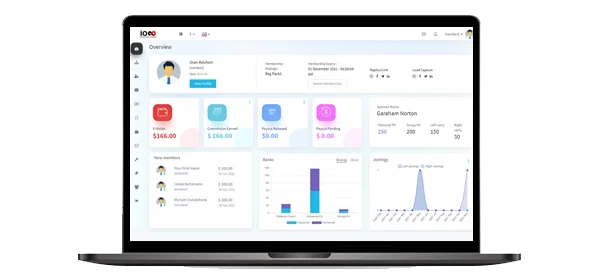Ever wondered about the real story behind the flashy promises of wealth in MLMs? The MLM Income Disclosure Statement holds the answers. This unassuming report holds the key to understanding the financial landscape of MLM companies and the actual earnings of their distributors. In this blog post, we’ll look at the significance of the MLM Income Disclosure Statement, exploring why it’s more than just numbers on paper. Come along with us as we look at the secrets of direct selling and how these statements bring clarity to the whole picture.
What is an MLM Income Disclosure Statement?
An MLM Income Disclosure Statement, often known as an IDS, is an earnings statement produced by MLM firms that acts as an accurate and dependable prediction of its distributors’ expected income. It is intended to be a precise and trustworthy estimate of the estimated income of its distributors. The Federal Trade Commission (FTC) requires MLM companies to update and publish their IDSs annually in order to protect consumers from being duped by misleading MLM practices.
Because of the unique structure and compensation plan that MLMs provide, an MLM company’s income disclosure statement may seem different from others’. The emphasis on hiring, the disparities in distributor success, and the necessity of transparency and regulatory compliance all have an impact on this disparity.
Significance of MLM Income Disclosure Statements
Prospective business owners in the MLM industry frequently come across income disclosure statements, which are an important detail that should not be disregarded. These documents are essential for enabling people to make well-informed choices about joining network marketing companies.
Here are five compelling reasons why MLM income disclosure statements are crucial:

Transparency in Earnings
MLM income disclosure statements offer a clear summary of the possible profits within the organization. Hence, you can easily carry out your MLM profit calculation. People may evaluate reasonable income expectations based on factual information rather than conjecture due to this transparency.
If an income declaration indicates that the majority of distributors make moderate incomes and only a tiny fraction generate big incomes, people will be better able to evaluate their MLM opportunity and modify their expectations.

Risk Assessment
These statements function as a tool for risk assessment, allowing people to determine the degree of financial MLM risk involved in becoming a member of a specific direct selling company. Potential members can make well-informed investment decisions by being aware of average earnings and success rates.
A thorough income declaration may reveal that a sizable percentage of distributors make minimum wage or lose money, which would let people consider the financial MLM risks before investing their time and money.

Realistic Expectations
MLM income disclosure statements highlight the differences in earnings between distributors, which helps to set reasonable expectations. People are better equipped with this knowledge to depict the rewards and difficulties of the multilevel marketing business model.
If the disclosure indicates that a small portion of participants attain high revenues with significant effort and talent, people can enter MLM ventures realistically, knowing the level of dedication necessary to succeed.

Informed Decision-Making
People can make sound decisions that are in line with their financial objectives and risk tolerance when they are equipped with the information revealed by income disclosure statements. Within the MLM community, this transparency promotes a culture of ethical entrepreneurship.
After reading an income disclosure statement, a potential joiner may decide to join an MLM knowing that consistent work and deliberate planning are necessary to make a great income.

Regulatory Compliance
MLM income disclosure statements help to ensure that MLM organizations follow industry standards, which helps to ensure regulatory compliance, according to FDC. Regulatory agencies frequently demand these declarations in order to uphold justice, stop deceptive advertising, and shield people from possible financial MLM risks.
Organizations that voluntarily furnish precise and comprehensive income disclosure statements exhibit a dedication to moral company conduct. As such, this augments their legitimacy and dependability in the perspective of prospective employees and regulatory bodies.
To sum up, MLM income disclosure statements is an earnings statement that MLM companies publish. Hence, they are incredibly useful resources that enable people to set reasonable expectations and confidently and openly negotiate the difficulties of the MLM industry.

Did you know?
The median income for MLM participants is less than $5,000 per year, according to income disclosure statements from various companies. This means that half of all participants earn less than this amount, and many earn significantly less.
The Impactful Purpose of MLM Income Disclosure Reports
MLM organizations frequently provide MLM Income Disclosure Statements as part of their efforts to be transparent and accountable. These records are an essential resource for the company and its independent distributors, providing insight into the MLM structure’s financial realities.
Let us look into six compelling reasons why MLM companies find it imperative to release these disclosure statements.

Legal Compliance and Regulatory Adherence
Disclosure of MLM Income Statements are frequently required by law and are not just a kind gesture. Hence, network marketing companies are required by regulatory bodies to furnish precise and unambiguous information about the profits, distributors, and MLM tax strategies. Companies can guarantee legal compliance and establish credibility with regulators and distributors by following these laws.

Enhancing Corporate Credibility
The foundation of corporate legitimacy is transparency. MLM companies exhibit their dedication to transparency and honesty by providing earning data through disclosure statements. This dedication cultivates confidence among current distributors, prospective hires, and the general public, ultimately strengthening the company’s standing.

Educating Distributors on Realistic Expectations
MLM Income Disclosure Statements serve as a reality check for aspiring and existing distributors. These documents present a clear picture of the income distribution within the organization, helping individuals set realistic expectations about their potential earnings. This, in turn, aids in managing the expectations of distributors and minimizing the risk of disillusionment.

Motivating and Retaining High-Performing Distributors
Effective distributors are the foundation of any direct selling company. MLM firms provide a motivating tool by displaying the potential earnings of top distributors through income disclosure statements. In addition to encouraging present distributors to aim for greater success, this also helps to keep successful people in the MLM network.

Identifying Areas for Improvement
MLM Income Disclosure Statements are not only about showcasing success stories in direct selling; they also highlight areas that may require attention and improvement. Therefore, MLM companies can spot patterns, discrepancies, or issues with their pay plan by examining the data. This knowledge is crucial for improving pay schemes and making sure the company has a just and long-lasting business plan.

Building Trust and Long-Term Relationships
Any MLM business that is successful is built on trust & customer experience. MLM companies establish a foundation of trust with their distributors by being transparent about their earning data. The company and its distributors benefit from offering customers the best MLM experience and long-term relationships that are fostered by this transparency. There is a greater chance of long-term success and growth when trust grows.
As such, MLM Income Disclosure Statements are essential in determining how direct selling companies are portrayed. By being transparent, these businesses not only meet their legal requirements but also build relationships, inform their distributors, and create the conditions for long-term, steady growth.

Did you know?
The income disparity in MLMs is often vast, with the top 1% of earners making significantly more than the rest. For example, a study by the Federal Trade Commission found that in one MLM company, the top 0.1% of earners made an average of $68,764 per year, while the median income for all participants was just $2,489.
Legal Requirements
Legal requirements for MLM companies to disclose income information vary by jurisdiction. Having said that, companies must overcome these regulations to maintain transparency.
Here are some common legal aspects associated with MLM income disclosure:
 Federal Trade Commission (FTC) Guidelines
Federal Trade Commission (FTC) Guidelines
The FTC in the US offers rules to multilevel marketing organizations. The significance of honesty and openness in business dealings is emphasized by these rules. MLMs are frequently obliged to give recruits and the general public accurate and understandable information regarding possible earnings.
 Securities and Exchange Commission (SEC)
Securities and Exchange Commission (SEC)
Compliance
An MLM may come under the SEC’s scrutiny if it involves the selling of securities or investment contracts. To prevent legal consequences in such situations, adherence to SEC regulations which includes complete and correct disclosure of income information is essential
 Consumer Protection Laws
Consumer Protection Laws
Laws protecting consumers’ rights in several nations mandate that businesses, including multilevel marketing companies, give truthful and unbiased information. This entails revealing any hazards, the nature of the business opportunity, and the average profits of distributors.
 Anti-Pyramid Scheme Legislation
Anti-Pyramid Scheme Legislation
Laws specifically tackling MLM pyramid schemes are in place in many places. MLMs are required to make sure that their business plan conforms with these rules, which frequently entails revealing income data to show that the company generates revenue from sources other than recruiting.
Maintaining awareness of the particular legal requirements in the jurisdictions in which multilevel marketing organizations operate is crucial. Legal challenges, fines, and reputational harm to the business may result from noncompliance with these regulations. MLMs can gain the public’s and their distributors’ trust by emphasizing transparency and abiding by the law.
Regulatory Bodies Overseeing MLM Practices
Regulatory agencies are essential in monitoring and controlling network marketing activities, guaranteeing adherence to legal requirements, and safeguarding customers.
Here are some notable regulatory bodies that oversee MLM practices:
 Federal Trade Commission (FTC)
Federal Trade Commission (FTC)
In the US, the FTC is a significant regulatory body in charge of MLM oversight. It offers rules and recommendations to stop unfair and misleading business activities, such as those involving MLM structures. The FTC highlights the significance of fair business practices, accurate revenue disclosure, and openness in the multilevel marketing industry.
 Securities and Exchange Commission (SEC)
Securities and Exchange Commission (SEC)
The SEC oversees MLM operations that entail the selling of securities or investment contracts. To ensure compliance with securities laws, safeguard investors, and preserve the integrity of the financial markets, multilevel marketers are required to abide by SEC standards.
 Direct Selling Associations (DSAs)
Direct Selling Associations (DSAs)
Industry groups such as DSAs, although not a regulatory entity, frequently set best practices and codes of conduct for multilevel marketing companies. Participating in these associations and upholding their standards can help multi level marketers look more credible and show that they are committed to moral behavior.
 Ministries of Trade and Commerce
Ministries of Trade and Commerce
Government bodies overseeing trade and commerce, such as ministries or departments responsible for business regulation, may have a role in regulating MLM activities. They can set policies, enforce regulations, and intervene in cases of non-compliance.
It’s important for MLM companies to be aware of and comply with the regulations imposed by these bodies to ensure ethical business practices, protect consumers, and maintain a positive reputation in the market. Regular updates on regulatory requirements help MLMs overcome the dynamic setting of compliance and contribute to the industry’s overall legitimacy.

Did you know?
Top earners, often less than 1%, are highlighted in income disclosures, overshadowing the majority who earn significantly less, and some even experience financial losses.
Key Elements in MLM Income Disclosure Statements
To ensure effectiveness, these statements should encompass key elements that offer a comprehensive view of the financial setting within the MLM structure. Here are the prime elements that should be included in MLM income disclosure statements:

Average Earnings Data
Provide clear and accurate information on the average earnings of all distributors. This should be presented in a format that distinguishes between active and inactive distributors to give a realistic representation of income levels.

Income Distribution
Break down the earnings distribution among distributors. Highlight the percentage of distributors earning at different income levels, such as top earners, mid-range earners, and those at the lower end. This breakdown helps individuals understand the range of potential earnings.

Timeframes and Durations
Specify the time frames associated with the earnings data. As such, differentiate between short-term and long-term income to convey that success in MLMs often requires time, effort, and persistence. This information aids in setting realistic expectations for distributors.

Expense Disclosures
Include information about potential expenses associated with running an MLM business. This can encompass product purchases, membership fees, marketing materials, and other costs. Disclosing expenses provides a more accurate portrayal of the net income distributors may expect.

Success Criteria
Define the criteria for success within the direct selling structure. Clarify the factors that contribute to higher earnings, such as recruitment, sales volume, or MLM training. Understanding the pathways to success helps distributors make informed decisions about their involvement in the MLM.

Risk Factors
Clearly articulate the risks associated with participating in the MLM, such as market fluctuations, changing consumer preferences, or the competitive setting. Highlighting potential challenges helps distributors assess the inherent uncertainties and make informed choices.
Explanation of Terms and Terminology
Define any terms or concepts specific to the MLM industry to ensure that the information is easily understood. Clarity in language and terminology eliminates confusion and enhances the overall accessibility of the disclosure statement.

Historical Data
Include historical income data to showcase trends and changes over time. This can help distributors gauge the stability and consistency of earnings within the MLM, providing valuable insights into the business’s track record.

Compliance Statements
Clearly state the MLM company’s commitment to compliance with relevant laws and regulations. This instills confidence in distributors and demonstrates the company’s dedication to ethical business practices.
By incorporating these key elements into MLM income disclosure statements, companies foster transparency, empower distributors with accurate information, and contribute to a more informed and ethical MLM industry.
Limitations of Income Disclosure Statement
 Selective Data Presentation : IDS often focus on averages, influenced by top earners, creating a skewed perception.
Selective Data Presentation : IDS often focus on averages, influenced by top earners, creating a skewed perception.
 Lack of Standardization : Absence of standardized reporting makes objective comparisons challenging.
Lack of Standardization : Absence of standardized reporting makes objective comparisons challenging.
 Limited Expense Insight : IDS often overlook expenses, leading to misconceptions about net income.
Limited Expense Insight : IDS often overlook expenses, leading to misconceptions about net income.
 Variable Distributor Engagement : The impact of individual effort and strategies is often ignored in IDS.
Variable Distributor Engagement : The impact of individual effort and strategies is often ignored in IDS.
Guidelines To Follow While Drafting An Income Disclosure Statement

Accuracy and Clarity
Present accurate and clear information in the income disclosure statement, using simple language and providing definitions for MLM-specific terms to build trust with distributors and regulators.

Standardization and Consistency
Establish standardized formats and reporting methods for income data to enable fair comparisons over different periods and within the MLM industry, promoting transparency and informed decision-making.

Comprehensive Expense Disclosure
Include detailed information on potential expenses, such as product purchases, membership fees, and marketing materials, to provide distributors with a realistic view of their potential net income.

Differentiate Between Active and Inactive Distributors
Clearly distinguish between the earnings of active & inactive distributors. This differentiation provides a more accurate representation of potential income for those actively engaged in the MLM.
Comparison Of Different MLM Companies & Their Income Potential
| Feature | Amway | Herbalife | Mary Kay | Avon |
|---|---|---|---|---|
| Product Focus | Diverse (home care, health & wellness, beauty) | Nutrition & weight management | Beauty & cosmetics | Beauty & personal care |
| Compensation Structure | Binary, hybrid | Unilevel with bonuses | Stair-step breakaways | Campaign-based commissions |
| Average Monthly Income | $50 – $200+ | $50 – $300+ | $50 – $250+ | $50 – $200+ |
| Top Earners | $100,000+ | $100,000+ | $100,000+ | $100,000+ |
| Startup Costs | Low (around $100) | Variable, depending on products | Low (around $100) | No initial purchase required |
| Training & Support | Online & offline resources, mentorship | Online & offline resources, coaching | Online & offline resources, workshops | Online & offline resources, sales representatives |
| Brand Recognition | High | High | High | Moderate |
| Recruiting Emphasis | High | High | Moderate | Lower than others |
| Potential Challenges | Saturated market, high competition, complex compensation plan | Potential legal issues surrounding products, reliance on recruiting | Competitive market, pressure to maintain customer base | Lower income potential, reliance on campaign sales |
Reflection
In wrapping up our journey through MLM Income Disclosure Statements, it’s clear that these documents are like windows giving a peek into the financial world of multilevel marketing. They show averages and possibilities, but individual success depends on personal effort and dedication. So, as you explore the MLM universe, keep an eye on these statements, seek the advice of wise folks, and don’t forget: your journey is uniquely yours.
We’d love to hear your take! Share your MLM experiences or thoughts about this blog in the comments below.
Disclaimer:
The MLM industry is dynamic, and companies may update their compensation plans and income disclosure statements. Readers are advised to verify the latest information directly from the official sources of the respective MLM companies.








